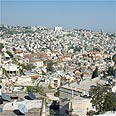
Nazareth. Largest Arab city
Photo: Jubran Hussam
In another 20 years, in the year 2030, one in every four Israelis will be Arab, according to figures published Wednesday by the Central Bureau of Statistics (CBS). The statistics show that Arabs already hold a majority of northern residents with 53% of the north, excluding Haifa, being Arab.
Life expectancy figures show that Jews have a longer life expectancy than Arabs. The life expectancy of an Arab man is 75.9 years. A Jewish man has four years longer on average to live. Arab women live on average 79.7 years, while Jewish women live on average three years longer than this.
At the end of 2008, 1.5 million Arabs lived in Israel . By 2030, the population is expected to grow to 2.4 million people, making up 24% of the general population in the country.
The report also shows that 70% of the Arabs in Israel were Muslims in 1950, whereas 83% currently are Muslim. On the other hand, the portion of Christians within the Arab population stood at 21%. This figure dropped to just 7% today.
Some 31% of Jerusalem's residents are Arab, 24% of Haifa, 16% of the south, and just 1% of Tel Aviv. The largest Arab city is Nazareth, with a population of 66,400. After it come Umm al-Fahm, Baqa-Jatt, Tayibe, Rahat, Shaghur, and Shfaram. Each of these towns has more than 30,000 residents.
Dropping fertility rates
In 2008, the Arab population grew by about 38,000 people as a result of a high fertility rate. The figures show that the Arab population is very young relative to the Jewish population. The median age of the Arab population is 20, while the median age among the Jewish population is 31.Arab families are bigger on average than Jewish families. An Arab family has 4.8 people on average, whereas a Jewish family has 3.5 people on average. Thirty-four percent of Arab families have six or more people, while this figure for Jewish families is just 9%.
However, fertility rates within the Arab population have dropped over the years. In 1965, an Arab woman would have 8.4 children on average. In 2008, an Arab woman would have just 3.6 children.
Arab women are quick to get married. The average age of marriage for a Muslim woman is 21.9. Since 1980, this number has decreased by one and a half years. Druze women marry at 22.5 on average; Christian women marry at 24.9 on average; Jewish women marry at 25.6 on average.
Among men, the picture is a bit different. Muslim men marry at 27 on average, Christians at 29.5 on average, and Jewish men at 27.8 on average.
The figures show that 54% of Arab men smoke, while only 5% of Arab women smoke. Among Jews, 28% of men smoke and 19% of women smoke.
In 2008, 42% of Muslims were eligible for a high school matriculation certificate, and 31% filled the requirements to enter university. Among Christians, these figures were higher – 57% and 53% respectively. Among the Druze these numbers were 53% and 37%. Among Jewish students, 54% were eligible for matriculation and 48% met the entry requirements for university.
The average Arab household income in 2008 was NIS 8,151 (about $2,185) per month, versus NIS 14,157 (about $3,795) per month among Jews.















